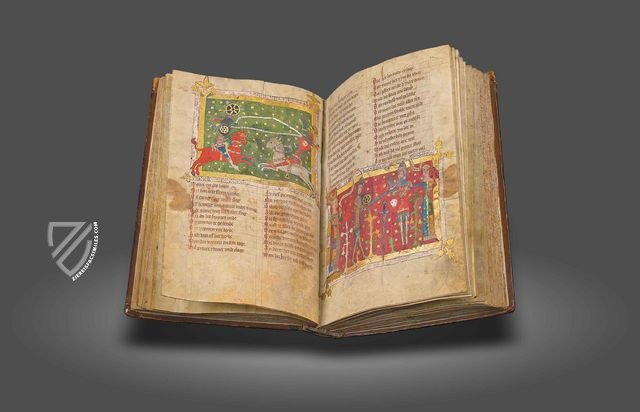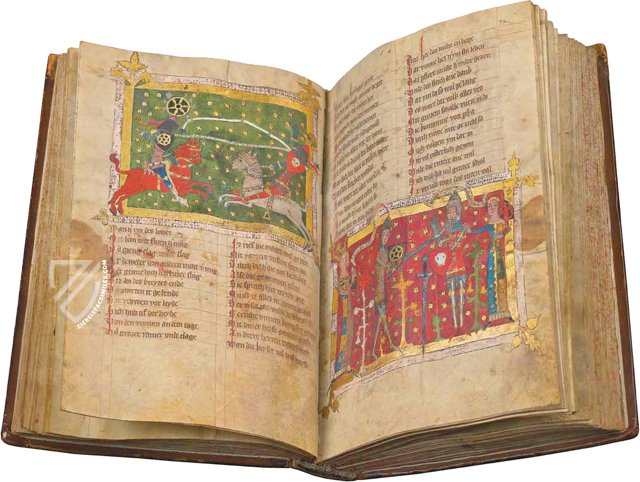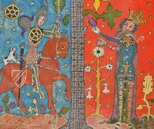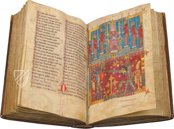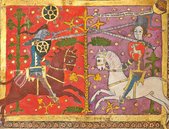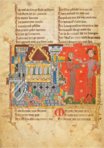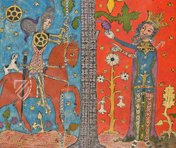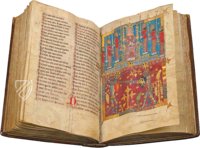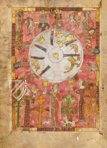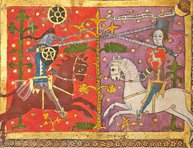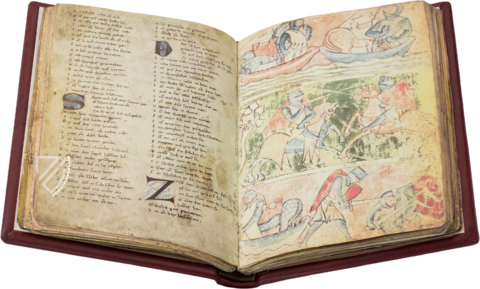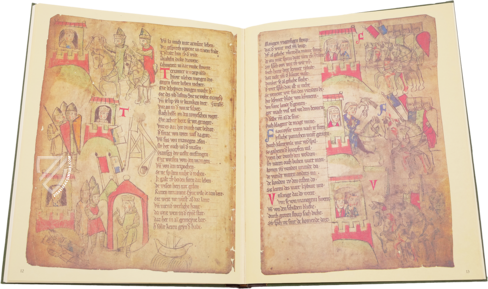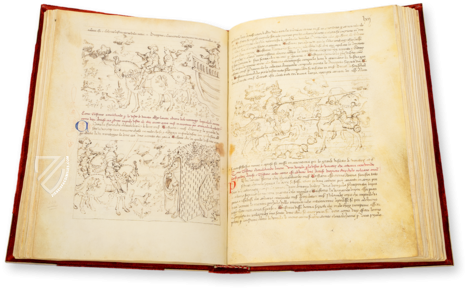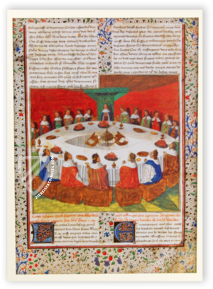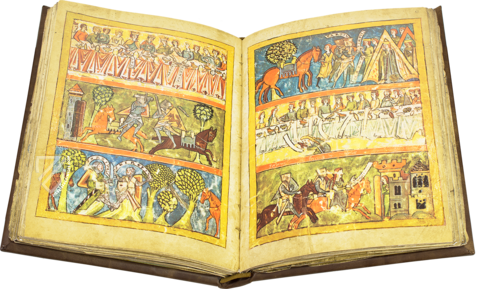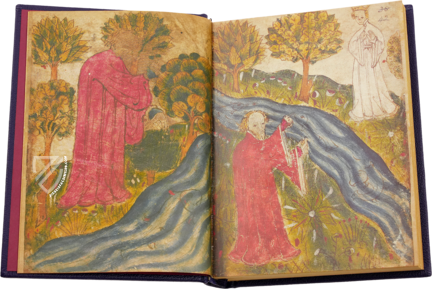Leiden Wigalois
The Leiden Wigalois is one of only two surviving illuminated manuscripts of the epic verse novel from the orbit of the Arthurian saga. Written between 1210 and 1220 by Wirnt von Grafenberg, the adventures of the aspiring knight Wigalois, son of the legendary Gawain, quickly became a bestseller of Middle High German courtly literature. Thanks to its comprehensive colophon, the origins of the precious Leiden manuscript are remarkably well documented: it was completed on January 6, 1372, by the scribe Jan von Braunschweig in the Cistercian monastery of Amelungsborn as a commissioned work for Albrecht I, Count of Braunschweig-Grubenhagen (c. 1339–1383). Particularly noteworthy and significant are the preserved prologue, a potential self-portrait of the book artist, and the 49 large and sometimes full-page miniatures, which create a kaleidoscopic effect with their intense colors and lavish gold decorations.
Leiden Wigalois
Two magnificent, full-page miniatures introduce the precious Leiden Wigalois Manuscript. The first page shows a gold-decorated, multicolored tree of life with a cross-shaped growth, around which numerous animals frolic. Turning the page reveals a full-page depiction of the famous Round Table on the reverse. Shiny gold and purple shades dominate the color palette of this royal scene.
Opposite, the verse novel begins with its remarkable prologue, in which the author lets the book speak to the reader: “What excellent person has opened me? / If it is someone who can read and understand me, / then let him treat me kindly, even if there is something to criticize about me, / and spare me from slander: this will honor him...”
Chivalrous Adventures and Courtly Love
The book then takes readers on the fantastical adventures of the knight Wigalois. He first arrives at the court of King Arthur to search for his father Gawain. There he undergoes knightly training, for which he must pass numerous knightly challenges that take him to foreign lands, a demonic otherworld, and to his great love. Again and again, he has to fight a whole bunch of enemies – from unfair rulers to giants and a scary dragon.
One of the Most Popular Arthurian Novels
The Nuremberg poet Wirnt von Grafenberg created this captivating tale in the form of a Middle High German courtly verse novel, probably between 1210 and 1220. The work quickly became a literary bestseller and, alongside Wolfram von Eschenbach's Parzival, was one of the most popular poems from the body of work based on the legendary world of King Arthur and his legendary Round Table. Of the 38 surviving manuscripts from the 13th to 15th centuries, only two have been illuminated. Of these, the Leiden Wigalois is without question the most magnificent.
One of Only Two Illuminated Manuscripts
This wonderful copy was commissioned by Count Albrecht I of Brunswick-Grubenhagen (c. 1339–1383) in the scriptorium of the Lower Saxony Cistercian monastery of Amelungsborn and completed on January 6, 1372 by the scribe Jan von Braunschweig (Jan van Brunswik), as the colophon at the end of the manuscript remarkably reveals. It is not entirely clear whether he was also responsible for the 49 colorful miniatures. If so, the last page of the precious manuscript shows a self-portrait of the artist – an absolute rarity in the Middle Ages! The portrait shows Jan in his traditional Cistercian habit at a writing desk, creating a lavishly illuminated page.
A Kaleidoscope of Colors, Patterns, and Gold
The striking miniatures captivate with their impressive colors and lavish gold decorations. The rather flat and reduced conception of the figures is accompanied by almost hypnotic and recurring patterns, which make castles look like structures made of colorful building blocks and give the miniatures in their entirety a kaleidoscopic effect. This makes them as captivating and wild as Wigalois' adventures, which they translate into images. Nevertheless, the knight in training is clearly recognizable throughout. He usually wears a helmet with a golden wheel as a crest, which also adorns his shield. The golden wheel of fortune is one of three mysterious, magical objects (wheel, magic belt, and stone of virtue) that accompany Wigalois on his adventures as lucky charms, but also as moral compasses. They also serve as symbols of his knightly virtues.
On the Trail of the Leiden Wigalois
This precious manuscript was initially owned by its patron, Count Albrecht I. In the 16th century, it probably came into the hands of the Protestant theologian Cyracius Spangenberg (1528–1604). He was the court preacher of the Counts of Mansfeld, in whose library the codex apparently ended up next through this connection. It is believed that Peter Ernst I of Mansfeld (1517–1604) took it with him to his residence in Luxembourg when he became governor there. The manuscript next appears in an inventory of the library of the Luxembourg scholar Alexander Wiltheim (1604–1684). Before 1789, it passed into the hands of Zacharias Henric Alewijn of Amsterdam, who bequeathed it that year to the Society for Dutch Literature (Maatschappij der Nederlandse Letterkunde), which ultimately transferred the codex to the Leiden University Library on long-term loan.
Codicology
- Alternative Titles
- Leidener Wigalois
Leidener Wigalois-Handschrift
Wigalois des Wirnt von Grafenberg
Wigalois by Wirnt von Grafenberg
Wigalois - Wirnt von Gravenberg
Ritter mit dem Rade
Knight of Fortune's Wheel
Handschrift B
Manuscript B - Size / Format
- 236 pages / 24.1 × 17.0 cm
- Origin
- Germany
- Date
- 1372
- Epochs
- Style
- Genre
- Language
- Script
- Gothic Textura
- Illustrations
- 49 miniatures, 5 of which are full-page, the rest half-page; various decorated initials
- Content
- Wirnt von Grafenberg's Arthurian novel about the adventures of the knight Wigalois
- Patron
- Albert I, Duke of Brunswick-Grubenhagen (c. 1339–1383)
- Artist / School
- Jan von Braunschweig (scribe)
- Previous Owners
- Cyracius Spangenberg (?)
Peter Ernst, Duke of Mansfeld (?)
Alexander Wiltheim (?)
Eustache von Wiltheim (?)
Zacharias Henric Alewijn
Bibliotheek der Maatschappij der Nederlandse Letterkunde
Leidener Wigalois
Wigalois' Tournament Battle Against the Steward of Roimunt
Against a two-part background of bright red and purple, Wigalois – recognizable by the wheel on his shield and corresponding helmet crest – and the Steward of Roimunt face each other in a joust. The latter is distinguished by the inscription above him: “Dit is eyn borchsetich ridder von roymunt” (This is a brave knight from Roimunt). While the battle ends in a draw according to the text, the miniature accentuates something else: Wigalois' lance smashes his opponent's helmet off his head, and the steward's lance hangs broken in the branches of the central tree.
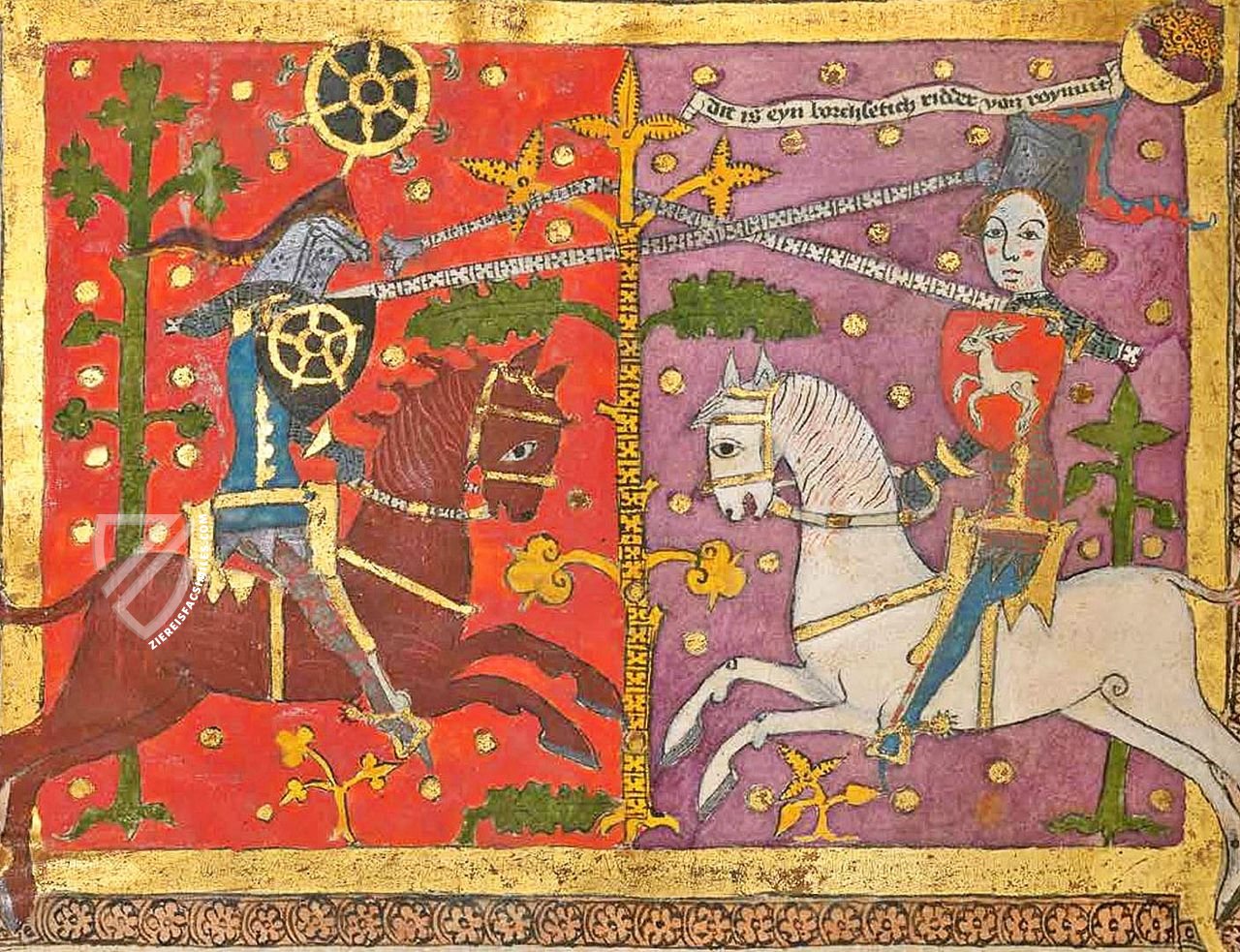
Leiden Wigalois
The Round Table
A full-page miniature of King Arthur's legendary Round Table introduces the richly illuminated manuscript. It sets the stage for the epic that follows in this mythical, courtly world full of heroes, adventure, and great love. The depiction also picks up on one of Wigalois' magical attributes: the fortune wheel.
The flatly depicted circular table is covered with various golden objects — bowls, goblet, and drinking horn. Six daggers are arranged between them in such a way that they resemble the spokes of a wheel. The number also fits, as Wigalois' wheel is usually depicted with six spokes throughout the manuscript.
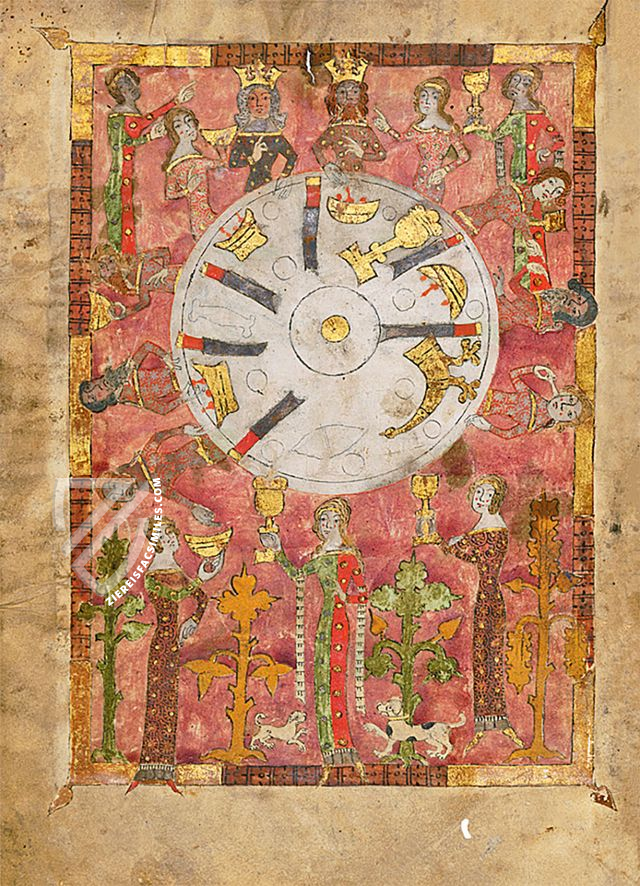
#1 Wigalois des Wirnt von Grafenberg
Language: German
The scholarly commentary volume includes a general introduction to the work and the author, a transcription and translation of the Middle High German text, its linguistic contextualization, and a detailed inventory and description of the miniatures.
- Treatises / Secular Books
- Apocalypses / Beatus
- Astronomy / Astrology
- Bestiaries
- Bibles / Gospels
- Chronicles / History / Law
- Geography / Maps
- Saints' Lives
- Islam / Oriental
- Judaism / Hebrew
- Single Leaf Collections
- Leonardo da Vinci
- Literature / Poetry
- Liturgical Manuscripts
- Medicine / Botany / Alchemy
- Music
- Mythology / Prophecies
- Psalters
- Other Religious Books
- Games / Hunting
- Private Devotion Books
- Other Genres
- Afghanistan
- Armenia
- Austria
- Belgium
- Belize
- Bosnia and Herzegovina
- China
- Colombia
- Costa Rica
- Croatia
- Cyprus
- Czech Republic
- Denmark
- Egypt
- El Salvador
- Ethiopia
- France
- Germany
- Greece
- Guatemala
- Honduras
- Hungary
- India
- Iran
- Iraq
- Israel
- Italy
- Japan
- Jordan
- Kazakhstan
- Kyrgyzstan
- Lebanon
- Liechtenstein
- Luxembourg
- Mexico
- Morocco
- Netherlands
- Palestine
- Panama
- Peru
- Poland
- Portugal
- Romania
- Russia
- Serbia
- Spain
- Sri Lanka
- Sweden
- Switzerland
- Syria
- Tajikistan
- Turkey
- Turkmenistan
- Ukraine
- United Kingdom
- United States
- Uzbekistan
- Vatican City
- A. Oosthoek, van Holkema & Warendorf
- Aboca Museum
- Ajuntament de Valencia
- Akademie Verlag
- Akademische Druck- u. Verlagsanstalt (ADEVA)
- Aldo Ausilio Editore - Bottega d’Erasmo
- Alecto Historical Editions
- Alkuin Verlag
- Almqvist & Wiksell
- Amilcare Pizzi
- Andreas & Andreas Verlagsbuchhandlung
- Archa 90
- Archiv Verlag
- Archivi Edizioni
- Arnold Verlag
- ARS
- Ars Magna
- ArtCodex
- AyN Ediciones
- Azimuth Editions
- Badenia Verlag
- Bärenreiter-Verlag
- Belser Verlag
- Belser Verlag / WK Wertkontor
- Benziger Verlag
- Bernardinum Wydawnictwo
- BiblioGemma
- Biblioteca Apostolica Vaticana (Vaticanstadt, Vaticanstadt)
- Bibliotheca Palatina Faksimile Verlag
- Bibliotheca Rara
- Boydell & Brewer
- Bramante Edizioni
- Bredius Genootschap
- Brepols Publishers
- British Library
- C. Weckesser
- Caixa Catalunya
- Canesi
- CAPSA, Ars Scriptoria
- Caratzas Brothers, Publishers
- Carus Verlag
- Casamassima Libri
- Centrum Cartographie Verlag GmbH
- Chavane Verlag
- Christian Brandstätter Verlag
- Circulo Cientifico
- Club Bibliófilo Versol
- Club du Livre
- CM Editores
- Collegium Graphicum
- Collezione Apocrifa Da Vinci
- Comissão Nacional para as Comemorações dos Descobrimentos Portugueses
- Coron Verlag
- Corvina
- CTHS
- D. S. Brewer
- Damon
- De Agostini/UTET
- De Nederlandsche Boekhandel
- De Schutter
- Deuschle & Stemmle
- Deutscher Verlag für Kunstwissenschaft
- DIAMM
- Droz
- E. Schreiber Graphische Kunstanstalten
- Ediciones Boreal
- Ediciones Grial
- Ediclube
- Edições Inapa
- Edilan
- Editalia
- Edition Deuschle
- Edition Georg Popp
- Edition Leipzig
- Edition Libri Illustri
- Editiones Reales Sitios S. L.
- Éditions de l'Oiseau Lyre
- Editions Medicina Rara
- Editorial Casariego
- Editorial Mintzoa
- Editrice Antenore
- Editrice Velar
- Edizioni Edison
- Egeria, S.L.
- Eikon Editores
- Electa
- Emery Walker Limited
- Enciclopèdia Catalana
- Eos-Verlag
- Ephesus Publishing
- Ernst Battenberg
- Eugrammia Press
- Extraordinary Editions
- Fackelverlag
- Facsimila Art & Edition
- Facsimile Editions Ltd.
- Facsimilia Art & Edition Ebert KG
- Faksimile Verlag
- Feuermann Verlag
- Folger Shakespeare Library
- Franco Cosimo Panini Editore
- Friedrich Wittig Verlag
- Fundación Hullera Vasco-Leonesa
- G. Braziller
- Gabriele Mazzotta Editore
- Gebr. Mann Verlag
- Gesellschaft für graphische Industrie
- Getty Research Institute
- Giovanni Domenico de Rossi
- Giunti Editore
- Graffiti
- Grafica European Center of Fine Arts
- Guido Pressler
- Guillermo Blazquez
- Gustav Kiepenheuer
- H. N. Abrams
- Harrassowitz
- Harvard University Press
- Helikon
- Hendrickson Publishers
- Henning Oppermann
- Herder Verlag
- Hes & De Graaf Publishers
- Hoepli
- Holbein-Verlag
- Houghton Library
- Hugo Schmidt Verlag
- Idion Verlag
- Il Bulino, edizioni d'arte
- ILte
- Imago
- Insel Verlag
- Insel-Verlag Anton Kippenberger
- Instituto de Estudios Altoaragoneses
- Instituto Nacional de Antropología e Historia
- Introligatornia Budnik Jerzy
- Istituto dell'Enciclopedia Italiana - Treccani
- Istituto Ellenico di Studi Bizantini e Postbizantini
- Istituto Geografico De Agostini
- Istituto Poligrafico e Zecca dello Stato
- Italarte Art Establishments
- Jan Thorbecke Verlag
- Johnson Reprint Corporation
- Josef Stocker
- Josef Stocker-Schmid
- Jugoslavija
- Karl W. Hiersemann
- Kasper Straube
- Kaydeda Ediciones
- Kindler Verlag / Coron Verlag
- Kodansha International Ltd.
- Konrad Kölbl Verlag
- Kurt Wolff Verlag
- La Liberia dello Stato
- La Linea Editrice
- La Meta Editore
- Lambert Schneider
- Landeskreditbank Baden-Württemberg
- Leo S. Olschki
- Les Incunables
- Liber Artis
- Library of Congress
- Libreria Musicale Italiana
- Lichtdruck
- Lito Immagine Editore
- Lumen Artis
- Lund Humphries
- M. Moleiro Editor
- Maison des Sciences de l'homme et de la société de Poitiers
- Manuscriptum
- Martinus Nijhoff
- Maruzen-Yushodo Co. Ltd.
- MASA
- Massada Publishers
- McGraw-Hill
- Metropolitan Museum of Art
- Militos
- Millennium Liber
- Müller & Schindler
- Nahar - Stavit
- Nahar and Steimatzky
- National Library of Wales
- Neri Pozza
- Nova Charta
- Oceanum Verlag
- Odeon
- Orbis Mediaevalis
- Orbis Pictus
- Österreichische Staatsdruckerei
- Oxford University Press
- Pageant Books
- Parzellers Buchverlag
- Patrimonio Ediciones
- Pattloch Verlag
- PIAF
- Pieper Verlag
- Plon-Nourrit et cie
- Poligrafiche Bolis
- Presses Universitaires de Strasbourg
- Prestel Verlag
- Princeton University Press
- Prisma Verlag
- Priuli & Verlucca, editori
- Pro Sport Verlag
- Propyläen Verlag
- Pytheas Books
- Quaternio Verlag Luzern
- Reales Sitios
- Recht-Verlag
- Reichert Verlag
- Reichsdruckerei
- Reprint Verlag
- Riehn & Reusch
- Roberto Vattori Editore
- Rosenkilde and Bagger
- Roxburghe Club
- Salerno Editrice
- Saltellus Press
- Sandoz
- Sarajevo Svjetlost
- Schöck ArtPrint Kft.
- Schulsinger Brothers
- Scolar Press
- Scrinium
- Scripta Maneant
- Scriptorium
- Shazar
- Siloé, arte y bibliofilia
- SISMEL - Edizioni del Galluzzo
- Sociedad Mexicana de Antropología
- Société des Bibliophiles & Iconophiles de Belgique
- Soncin Publishing
- Sorli Ediciones
- Stainer and Bell
- Studer
- Styria Verlag
- Sumptibus Pragopress
- Szegedi Tudomànyegyetem
- Taberna Libraria
- Tarshish Books
- Taschen
- Tempus Libri
- Testimonio Compañía Editorial
- Thames and Hudson
- The Clear Vue Publishing Partnership Limited
- The Facsimile Codex
- The Folio Society
- The Marquess of Normanby
- The Richard III and Yorkist History Trust
- Tip.Le.Co
- TouchArt
- TREC Publishing House
- TRI Publishing Co.
- Trident Editore
- Tuliba Collection
- Typis Regiae Officinae Polygraphicae
- Union Verlag Berlin
- Universidad de Granada
- University of California Press
- University of Chicago Press
- Urs Graf
- Vallecchi
- Van Wijnen
- VCH, Acta Humaniora
- VDI Verlag
- VEB Deutscher Verlag für Musik
- Verlag Anton Pustet / Andreas Verlag
- Verlag Bibliophile Drucke Josef Stocker
- Verlag der Münchner Drucke
- Verlag für Regionalgeschichte
- Verlag Styria
- Vicent Garcia Editores
- W. Turnowski Ltd.
- W. Turnowsky
- Waanders Printers
- Wiener Mechitharisten-Congregation (Wien, Österreich)
- Wissenschaftliche Buchgesellschaft
- Wissenschaftliche Verlagsgesellschaft
- Wydawnictwo Dolnoslaskie
- Xuntanza Editorial
- Zakład Narodowy
- Zollikofer AG

